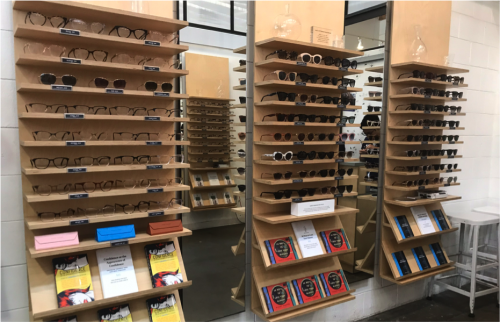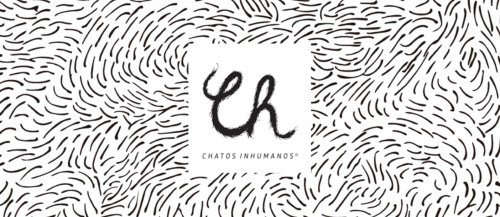
by Shannon Eagen
WARBY PARKER AND THE BRANDING OF BOOK CULTURE
On a recent vacation to Chicago, I spent an afternoon exploring the hip Lincoln Park neighborhood that was my home for the week. I stumbled upon a Warby Parker store and was immediately consumed with trying on every pair of chic, oversized glasses within my reach. In between viewing myself in frames labelled “Milton,” “Wilder,” and “Baker,” I also picked up a free guide titled, “Best Spots in Chicago to Sit and Read a Book.” My delight in finding book-nerd compatriots — even though I hadn’t spoken to anyone — somehow transformed into a burning desire to buy some glasses. I scheduled an impromptu eye exam, and in less than an hour I had purchased a new pair of prescription frames. It was not unlike a trip to a bookstore, where I enter with every intention of just browsing and leave with more books than I can carry.
Literary entrepreneur and publishing veteran Richard Nash would say this transformation was anything but coincidental. In a lecture this summer at the LARB/USC Publishing Workshop, Nash disclosed that I had walked into not only a store, but a branding strategy. Warby Parker has intentionally modeled their shops after bookstores and libraries to make people like myself feel comfortable and expansive.
Being a millennial contrarian, I was disappointed in myself for having been seduced by this corporate scheme. Had I really been duped into spending a hundred bucks by a beautiful display of color-coordinated books? Is it even rational to feel, as I did in this instance, that literature should be immune to capitalism? This principle seems to hold water when you browse a used bookstore and find a copy of a masterpiece — say, The Grapes of Wrath — for 50 cents. But I’ve also had no problem spending money on newer books; in fact I actively seek out physical copies, shunning the cheaper ebooks I can download in seconds. I realized that Warby Parker had, inadvertently, brought out my inner Holden Caulfield. In my mind now, the store was “full of phonies,” who were attempting to cash in on literary cachet. To settle this internal debate, I decided to further explore Warby Parker’s relationship to the world of publishing.
Being a millennial contrarian, I was disappointed in myself for having been seduced by this corporate scheme.

by Shannon Eagen
Warby Parker is a combination of two characters who appear in one of Jack Kerouac’s journals: Warby Pepper and Zagg Parker. New WP employees are given a copy of another Kerouac novel, The Dharma Bums, to read during orientation. As we’ve seen, there is also a palpable “litfluence” on the names of their frames; customers can choose whether they identify as a Finch, a Langston, or a Beckett. In addition to their free local lit guides, Warby Parker also sells a variety of books in their stores, ranging from classics to new releases. Finally, in 2015, Warby Parker took on the role of publisher, releasing the coffee-table book Fifty Ways to Lose Your Glasses, with whimsical illustrations by Brooklyn-based artist John Lee.
Did Warby Parker’s embrace of book culture run deep, or did it all come down to a corporate debasement of the the sanctity of books? I called up Richard Nash to help me parse this messy relationship between books and commerce, and maybe re-examine my own possibly naive ideas about literary sanctity.
According to Nash, the merger of money and literature, whether it be the Royal patronage of Shakespeare or the pressing financial need of Dostoyevsky, “is not a stain on the text, but a part of the text,” and is therefore worthy of consideration in literary analysis. Since the 1970s, proponents of the so-called New Historicism, such as Stephen Greenblatt, have argued that the value of the text cannot be separated from the circumstances under which it was produced — even if some purists might feel uncomfortable with the monetary influences at play in the literary world. Nash went on to explain that we may “choose for [ourselves] how to treat and examine a book.”
“But if you strip it of the capital context, you are opting to ignore — not protecting or saving the book from degradation,” he added. To him, we do books a disservice when we overlook this analytical framework. I realized my mistake in attempting to separate the joy and meaning of a physical object from the inherently capitalist nature of its production.
I was still confused, though, about the efficacy of bookstores as a template for selling fashion. While millennials have been blamed for killing everything from fabric softener to Applebee’s, let’s remember that a love of convenience knows no age group. The decline of the bookstore began before the current generation of twenty- to thirty-somethings kicked off their murderous spree. Amazon entered the bookselling sphere in 1995, before the majority of this oft-maligned generation could exert any true purchasing power. By 1997, Amazon was claiming to be “the world’s biggest bookstore,” and a little over a decade later, not unrelatedly, former powerhouse Borders Group declared bankruptcy. All because people seeking a deal chose Amazon over a trip to the bookstore. Like Amazon, which offered the ease of scratching your bookish itch without having to leave the house, Warby Parker began as an online company touting the convenience of trying on multiple pairs of glasses from the comfort of your own home.
I realized my mistake in attempting to separate the joy and meaning of a physical object from the inherently capitalist nature of its production.

by Shannon Eagen
Why, then, would a successful e-commerce company choose to emulate the experience of a seemingly failing industry?
Nash suggests that the actual value of the bookstore is not in the selling of books, but in the sharing of stories and cultural experiences. In a Fast Company profile of Warby Parker, Co-CEO Neil Blumenthal revealed that WP stores are “not profit centers as much as marketing collateral.” In other words, the stores exist to enhance the brand just as much as they do to sell glasses. By removing the pressure to invest in new frames from the equation, Warby Parker stores encourage the comfortable, non-committal browsing experience that similarly draws passersby into local bookstores. Warby Parker was named Fast Company’s “#1 Most Innovative Company” in 2015, and that innovation is evident in their successful creation of a lifestyle brand that reaches far beyond that of a typical eyeglass retailer. I for one have certainly never taken time out of a vacation to explore a Lenscrafters. With my new parameters for examining the relationship between literature and capitalism in place, I went back to Warby Parker to investigate the real influence of book culture on a typical store.
I headed to the downtown Los Angeles Warby Parker, nestled in the rapidly gentrifying Arts District. Housed in Alchemy Works, an open-concept retail gallery, the glasses store is located past a small maze of bohemian clothing and pricey knicknacks. I took in the smattering of contemporary fiction, spotted several copies of Fifty Ways to Lose Your Glasses, and noticed a second original publication from the Warby Parker imprint — a book of puzzles by Will Shortz. As one of the bespeckled employees helped me adjust my frames, I asked a few questions about the literary side of the store. I quickly learned that the employees are not required to read the books, though one young man did recommend Swing Time by Zadie Smith. When I asked about the lack of Kerouac books in the store, a young woman in cat-eye frames informed me that it would almost be a cliché for them to sell his books at this point. Despite a few very pointed questions, no one mentioned The Dharma Bums as being required orientation reading. A new hire confessed that she hadn’t read any of the books in the store and had no intention of reading them any time soon. One thing that surprised me was talk of the rapidly expanding number of physical stores, and a sense that the retail locations fare quite well in spite of their convenient online alternative.
Ultimately, I sensed very little connection between the literary and the day-to-day operations of the Warby Parker stores. But I also felt unperturbed by that fact. Just as a bookstore is meant to be casually browsed, and booksellers willingly provide guidance without requiring customers to actually buy anything, the Warby Parker employees indulged my curiosity with a sort of indifference to my purchasing power. Even if this Warby Parker store wasn’t a hub of stimulating literary discussions, it certainly did capture that comfortable feeling I have when wandering aimlessly through a bookshop.
As I left the store, my Keene frames expertly tightened, a young couple came in “just to look around,” and I tipped my hat to the success of Warby Parker’s brand allure.
 SHANNON EAGEN
SHANNON EAGEN
Shannon Eagen is an actress, writer and aspiring publisher living in Los Angeles. She is a proud graduate of the University of Michigan with a BFA in Theatre and a BA in Communications. She was featured in the Tony-nominated Broadway play Airline Highway, and was most recently seen in Guess Whom? in the Hollywood Fringe Festival. She is an avid bookworm, who always reads the book before seeing the movie.











